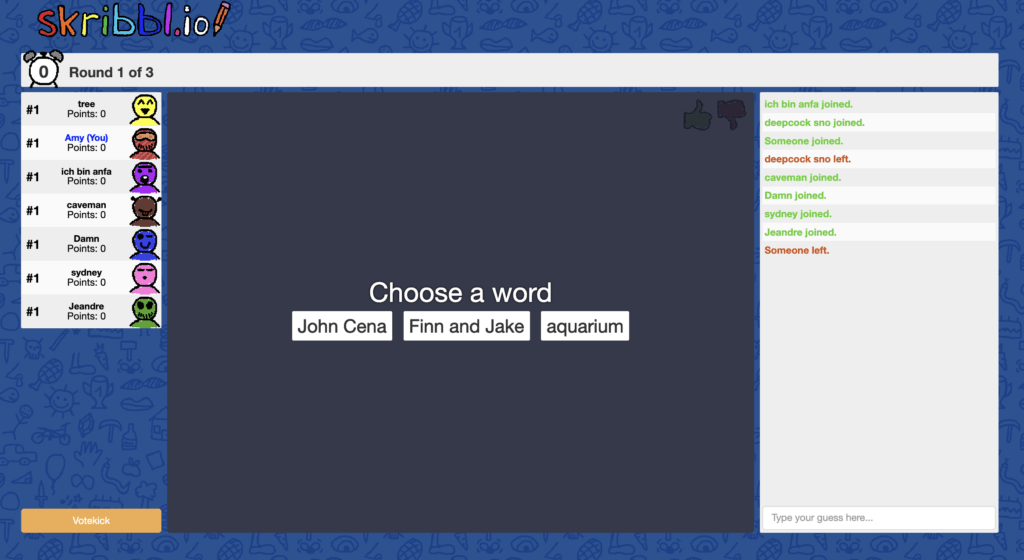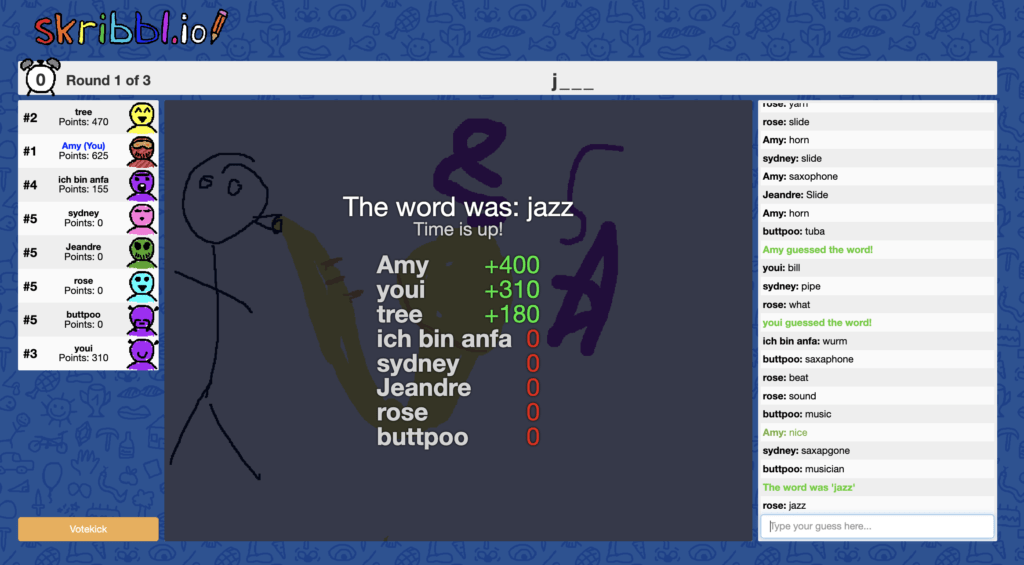Skribbl.io is a game by ticedev released in February 2017 that is hosted as a web application online. Its target audience seems to be ages 8+ or any age where people are capable of typing, drawing, and understanding how to read. Skribbl.io is a multiplayer game that can be played both with private and public, anonymous groups up to 12.
How to Play

As the game creator, you can also set the number of rounds, the draw time from 30 seconds to 180 seconds, the language, and custom words that you can use inclusively or exclusively in the game.

Similar to Pictionary, each player gets a turn to draw and makes a choice between three words to draw.

The other players will wait as you choose a word during your turn.

Once your turn starts, players will be provided with the number of letters in the word. Players will type guesses in the chat, which functions both as a normal messaging platform and as a core mechanic in the game. As players guess correctly, their name area will turn to green in the game, as seen on the left, and a message will appear in the chat, as seen on the right.

To gain points in the game, you have to guess the word correctly within the time limit. The faster that you guess, the more points that you score. Additionally, the drawer also gets points the more people guess correctly as an additional incentive. As the time counts down, more letters of the word are revealed. If a player doesn’t guess in time, then they don’t receive any points.
A round ends when everyone has drawn for a turn. Then, the game ends and the points of all the rounds are summed, which determines the winner.
Formal Elements
Players: Each game can have up to 12 players. The game is a multiplayer game that is won by scoring the most points. However, it can also feel like player vs. game when you, the drawer, are fighting against the constraint of time.
Objective: The objective of the game is to race against the other players to score the most points and to guess the correct word the fastest. However, the objective could also be outwit. You want to guess correctly and quickly, but you don’t want to give away too much information about your guesses as you play.
Resource: Time is the most important resource in the game, where both guessers and drawers are fighting against time to either race to the correct response or draw a good interpretation of the word, respectively. Another resource in the game is the chat, which serves as a method of communication and the way to play. When I played anonymously with other players, the chat was an extremely useful resource because others’ previous guesses serve as a hint to what hasn’t worked in the game or they may have come to a correct guess.

Another helpful resource as the drawer was the colors and different thickness of brushes that you could use. On one hand, these resources could be helpful to communicate your idea visually, but on the other hand they can sometimes paralyze you as you have to quickly make a judgment which color, pen, and method of drawing will serve you best.
Constraint: As mentioned above, time serves to constrain the opportunities for the drawer to draw and the guessers to guess.
Conflict: Conflict is created through the words in the game that present challenges for the drawers and guessers. However, I found that conflict also arose when players were frustrated by the quality of the drawer and the visual communication between the drawer and the guessers.
Boundary: The main boundary is in the visual area on screen where people draw. People find creative ways to interact with this boundary by using the blank screen as a canvas. However, the boundary can also be expanded to the conversations and communication you have beyond the game, as my friends and I have also frequently called while playing together.
Comparison to other games in its genre
Compared to other judging games in the genre, Skribbl.io stands out because of the ways players interact with the prompts. By drawing the words, players are adding their own interpretation and visual identities to the game, which is a part of what makes it fun. Like Charades or Heads Up, it’s up to the players to determine how they want to communicate with the other players without giving the word away.
However, what Charades or Heads Up do better is that by acting out words in-person, this gives players more opportunity to be silly, fun, and expressive. This is because you have more resources – the room, your body, other people who aren’t playing – to help you communicate your objective.
In a way, I feel like the fact that this game is digital and not analog limits the game as well because you have less methods of interaction with other players.
Type of fun
The type of fun in this game is expression, as the game is centered around drawing. This is done through the mechanics of the turn-based drawing and the resource of color, weight, and pen tools. The challenges that the game creates as mentioned above makes the expression more fun as it forces you to think creatively on how best to communicate your word. This game does accomplish its goal through the mechanisms, but leaves some to be desired with player-player interactions detailed below.
Vulnerability in the game
Because you’re given prompts to draw and a specific task to guess, players do not need to get vulnerable with the game. Because players are focused on a specific word, they don’t need to really share information or personal identities with each other. To some extent, you can try to communicate your identity through your drawings, but this seems limited. Thus, it’s hard to be vulnerable because of the resource constraints.

The blank canvas and unmoderated chat can be used in hurtful ways, as I saw when I played anonymously in public rooms. The anonymity of the game in public rooms makes it easier for people to hide behind a screen. This may be why the game creator introduced a way of voting to kick players out of the game. If a majority of players votekick the current player, they will be removed from the room. Players can also thumbs up or down people’s drawings to provide feedback for the drawer. I found it super difficult to feel vulnerable in public games compared to more private games because of the misbehavior of certain players in anonymous settings.
Suggested changes
- I would add some voice features in the game for private rooms to join calls and talk to each other as they draw. I noticed this occurring naturally anyways as people join Discord calls to talk as they play.
- I would also add categories to draw so that players could guess from a more focused set of words. Having a set of words for the game that people can choose from might reduce some of the drag or friction when players get stuck or frustrated with not getting any correct guesses.
- I would offer more safety features such as blocking players or reporting players so the game does not rely on a majority of players to kick someone out. This would make it safer for kids and other players of marginalized groups to play in public rooms.


